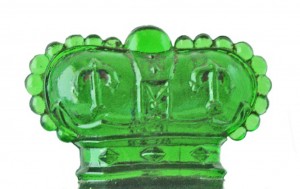One of the preeminent perfumeries of its day, The Crown Perfumery Company’s philosophy was to offer high quality perfumes to everyone, everywhere. Crown perfumes were available on the boulevards of Paris; in the pinnacled city of Constantinople; at the Viennese Court; inside the imperial palaces of the Czar; among the great cities of North and South America, within the walled cities of the Orient; across the deserts of Africa; around the Indian Empire; and throughout the lands “down under” — Australia and New Zealand. [9]
Crown was a global enterprise in a time when this was a rare accomplishment. Their genius came when they branded their scents with an eye-catching crown stopper, forever associating themselves and their clients with royalty. Society took notice, gave their approval and became loyal followers.
They had scents reminiscent of a favorite flower (Frangipanni, Sweet Pea, White Lilac, Wild Azalea); a season (Aroma of Spring, Noel, Holly); an area (Fleur d’Azur, Perle des Indes ), a place (Bouquet Versailles, Isle of Wight Bouquet, Buckingham, Sandringham) and scents which were artfully blended (Couronne d’Or/Crown of Gold, Matsukita).
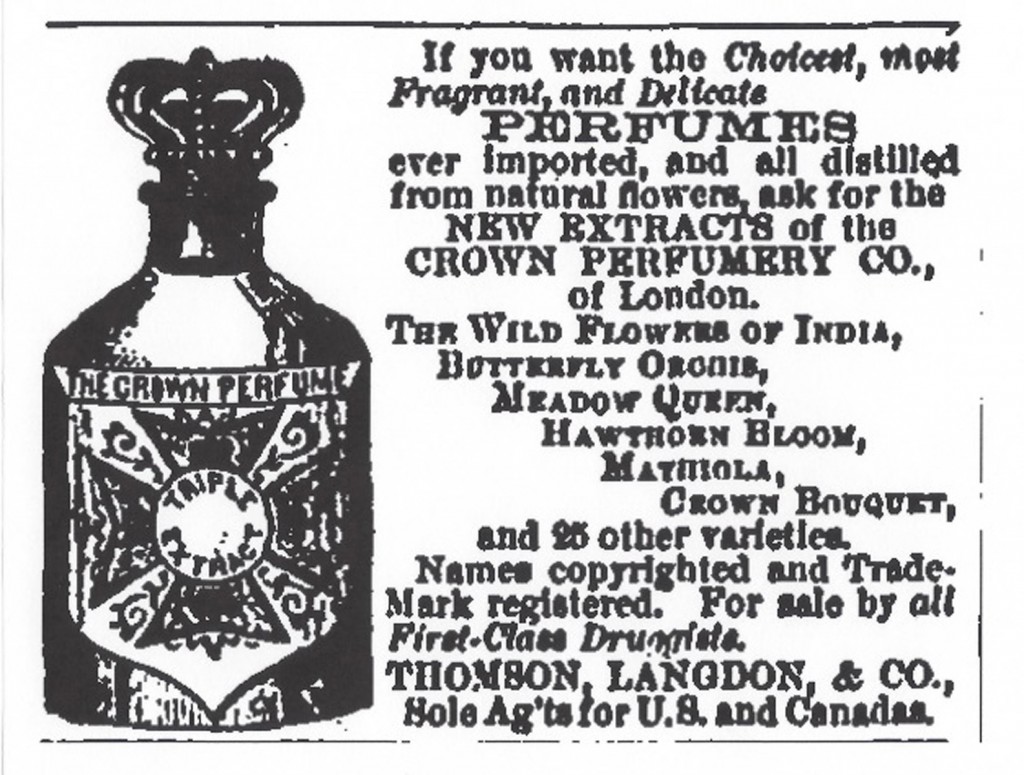
November 23, 1872 [10]
Their first advertised perfumes were Meadow Queen, Wild Flowers of India, Mathiola, Butterfly Orchis, Crown Bouquet and Hawthorn Bloom. The scents were delicate, refined, rich, lasting and all natural. Additional scents quickly followed. At a time when the natural essence of violet was expensive to create and difficult to master, and when their competitors used chemicals to produce this fragrance, The Crown Perfumery Company used only the genuine essence of violets from the gardens on the Riviera.
Their fame was such that contemporary writers invoked their name to quickly establish a characters’ place within society.
Dona Etelvina wasted no time in doing so. She brought with her an exquisite fragrance, the scent of opopanax, which back then was the most chic perfume, the one of the greatest nouveaute that The Crown Perfumery Company, of London, distilled in its factory. Her dress, her little hat, her movements, her manners…all of it was, or aspired to be, distinguished. It could be said that the latest fashion plate in Elegant Fashions Illustrated had taken on human dimensions, had acquired life by magic, and had come there on a visit. [11]
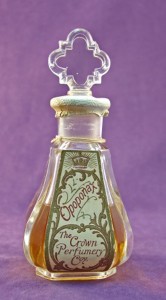
Used since biblical times, opoponax is a gum-resin with an earthy, sweet, balsam-like fragrance. It is also known as sweet myrrh.
Inspiration for the beloved perfume Crab Apple Blossoms was right under William Sparks Thomson’s nose — a Crab Apple tree sat in the very center of the front lawn of his London home. Imagine his surprise during his first spring at Sidmouth Lodge, Kensington, when the tree bloomed profusely, scenting the air with a soft, rich fragrance. As a connoisseur of scent, he began experiments to reproduce the sublime fragrance. Thomson definitely succeeded! His creation brought fame and fortune to The Crown Perfumery Company. This delicate and fresh perfume was a scent society cherished for fifty years. There is a very telling account from Bangor, Maine that places the blame for the shortage of apples in the autumn of 1893 on this perfume. According to the article, all of the blossoms had been gathered for the perfume, leaving none to produce apples — and yet twice as many blossoms were still needed.
From Trademark applications, Crab Apple Blossoms (Malus Coronaria) was first produced in 1886. There are some references for a much earlier date, but I have found no evidence to support this. As was the case with Crown Lavender Salts, had Crab Apple Blossoms been created in the 1860s or 1870s, Thomson would have been advertising the perfume, for this was his creation, his best-selling perfume. The earliest reference to Crab Apple Blossoms in print which I have seen is January 1887. Sales were fantastic. Over 200,000 bottles were sold annually by 1889. By 1894, over half a million bottles were sold annually. The last advertisement I have seen is 1937.
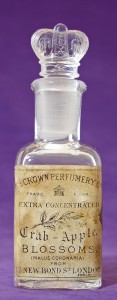
Crab Apple Blossoms (Malus Coronaria) was advertised in the above bottle and sold everywhere. This was the standard bottle. As part of the Gold Label Series, an extra fine concentration of Crab Apple Blossoms was sold in luxurious packaging along with complimentary toiletries of Eau de Toilette, Poudre de Riz (face powder), soap and sachet.
Crab Apple Blossoms was also part of the Delectys Series, offered in their highest perfume concentration and nested in a glamorous box. Other items in this series included Poudre de Riz, Soap, Toilet Water, Lotion for the Hair, Huile Antique, Brillantine, and Sachet.
A select number of Crown perfumes were presented in a variety of cut glass bottles and atomizers. Crab Apple Blossoms and several other perfumes were available in the cut, polished and silver collared bottle shown below.
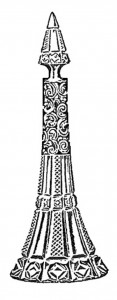
c. 1900 Trade catalog
Retail merchants had the option of ordering individual perfumes in a variety of bottles and boxes depending on the desires of their clientele. Goutte d’Or was available in a square crystal bottle in a plain white case. A stylish casket of Lyons silk held the same bottle for a few shillings more. A more expensive presentation at almost twice the price of the first item was Goutte d’Or cushioned in a handsome leather case.
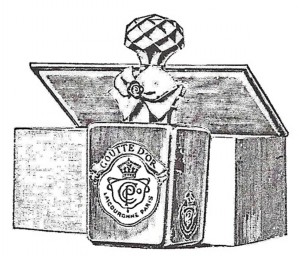
Goutte d’Or crystal bottle with a Lyons silk casket
c. 1900 Trade catalog
The most expensive perfume, circa 1900, was Couronne d’Or. Crown of Gold. When 2 ¼ ounces were placed in the crystal bottle below, the wholesale price was $1,175.00 in 2014 dollars!
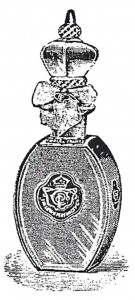
c. 1900 Trade catalog
Matsukita du Japon, “Redolent of the Land of Flower,s” was one of the richest perfumes created by The Crown Perfumery Company. An “intoxication of delight,” it was unlike any perfume – ever. When layered over Crab Apple Blossoms, the two scents produced a new, complex and more luxurious scent. Women wore Crab Apple Blossoms during the day, then applied Matsukita du Japon to their pulse points in preparation for a special evening out. Perfume layering was an untried concept which was popularized by socialites.
An intriguing thought occurs when studying two advertisements for Matsukita. Are these advertisements drawn by William Thomson, the son? The signature resembles his known signature. He was an accomplished artist who exhibited at The Royal Academy of Arts in London and at the World’s Columbian Exposition in Chicago. It is a strong possibility…
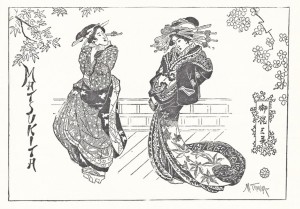
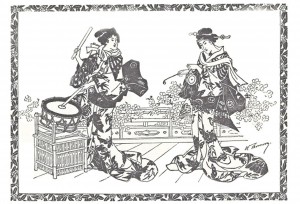
Two Matsukita advertisements, possibly drawn by William Thomson
1894[12] 1895[13]
Introduced around 1906, Jazmin del Pais was another successful scent for The Crown Perfumery Company. This high quality perfume in a cut glass bottle with faceted stopper was placed in a grey suede box. The label was also grey suede with a large metal crown attached. A round turquoise knob was attached to the outside of the box. Soap, Poudre de Riz, eau de toilette, lotion, sachets and brillantine were other items scented with Jasmin del Pais. The line, with the addition of bath crystals, continued to be a success for William Gossage & Sons, Ltd. in the 1920s. The last advertisement found is dated 1937 for Jazmin del Pais soap.
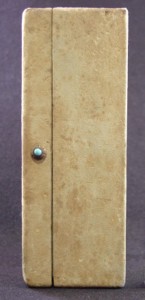
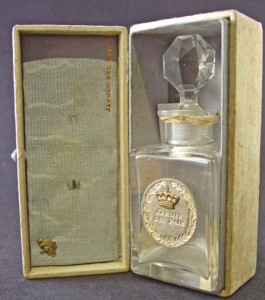
The crystal bottle is 4.5″ / 11.5 cm tall
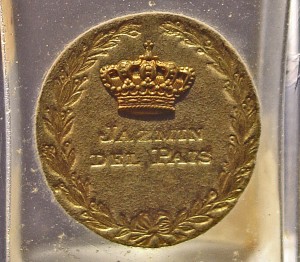
A close-up view of the grey suede label with its metal crown.
Lune de Miel, (Honeymoon) was advertised in 1910 with the same cut crystal bottle as Jazmin del Pais.
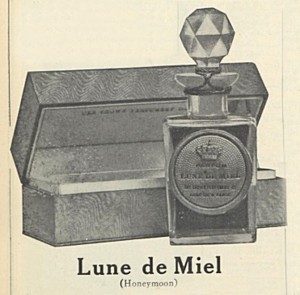
December 1, 1910[14]
Iroma, a floral perfume, was awarded the Grand Prize medal at the Festival of Empire Imperial Exhibition and Pageant of London in 1911. Scented toiletries included Poudre de Riz, soap, lotion for the hair, brillantine and sachets. The entire front page of the Daily Mail newspaper on May 31st, 1912 was an Iroma advertisement.
There is a charming press account of the Ash Vicarage Fete in Somerset, England in the summer of 1912. Mrs. Fulton donated numerous Iroma sachets to this charity event. To the delight of the organizers, the sachets quickly sold. Not so delighted was the Vicar the following Sunday when there was a noticeable distraction of Iroma permeating the church!
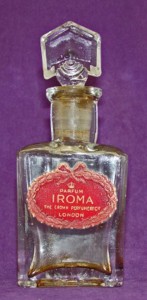
4.5″ / 11.5 cm
In the language of flowers, Violettes de Parme translated to “perfect beauty.” Crown’s “perfect beauty’”perfume was a favorite among society. The perfume was offered in various collections of their best quality fragrances: Gold Label Series, Crown Royal Series and the Delectys Series.
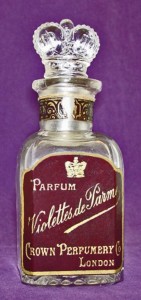
An early Gold Label Series crystal bottle
4.5″ / 11.5 cm
William, Annie and Charles Thomson sold The Crown Perfumery Company of London to William Gossage & Sons, Ltd. in 1921. The new firm was The Crown Perfumery Company Ltd. Gossage was a soap manufacturer, owned by another soap manufacturer, Lever Brothers. Lever Brothers then merged with the Dutch firm Unie Margarine to form Unilever in 1930.
The Crown Perfumery Company Ltd. discontinued most of the fragrances, retaining about two dozen scents, including Crab Apple Blossoms, Heliotrope, Jazmin del Pais, Lily of the Valley, Jockey Club, Violet, Wallflower and White Rose. Crown Lavender Salts was most definitely retained.
Contemporary writers state that during the 1920s and 1930s, “x perfume was inspired by celebrity y.” This does not make sense as the majority of these perfumes have introduction dates several decades earlier. Perhaps these classic perfumes never went away and were continued by William Gossage & Sons, Ltd. Perhaps these perfumes were re-formulated and updated. A few of the men’s scents are from this time period and thus could have been developed for, or inspired by, specific gentlemen. If we know that these famous men and women, society’s darlings, were wearing Crown perfumes, then the company did not lose its allure and quickly fade away after being sold by the Thomson children in 1921.
| Scent | Developed for / Inspired by |
Earliest Known Date |
| Crown Alpine Lily | Empress Sissy | 1879 |
| Crown Bouquet | Wallis Simpson | 1872 |
| Crown Bouquet | Greta Garbo | 1872 |
| Crown Court Bouquet | Lady Astor | 1875 |
| Crown Heliotrope | Ava Gardner | 1875 |
| Crown of Gold | An Arabian Princess | 1910 |
| Crown Stephanotis | Isadora Duncan | 1873 |
| Sarcanthus | Amy Johnson | 1900 |
| Tanglewood Bouquet | Greta Garbo | 1874 |
| Crown Fougere | Charlie Chaplin | 1885 |
| Crown Park Royal | Edward, Duke of Windsor | 1929 |
| Crown Spiced Limes | Lawrence of Arabia | 1921 |
| Eau de Quinine | Oscar Wilde | 1890 |
| Marquis | Gary Cooper, worn by | 1928 |
| Sumare | King Faud I of Egypt | 1900 |
| Town and Country | Winston Churchill | 1925 |
The Crown Perfumery Company Ltd. ceased the manufacturing and supply of their products on December 31, 1937. Other companies within the Unilever house continued production of a very limited selection of Crown items for a few more years.
Known Perfumes of The Crown Perfumery Company
and The Crown Perfumery Company Ltd.
| Scent | Earliest Date | Scent | Earliest Date | Scent | Earliest Date | ||
| 1872 – 1921 | Ambree | 1899 | Aroma of Spring | ||||
| Asphodel | 1889 | Astrabel | 1908 | Bengali Bouquet | 1873 | ||
| Bouquet Versailles | 1898 | Brise d”Amour | 1900 | Butterfly Orchis | 1872 | ||
| Caprice des Fees | 1900 | Carnation | 1900 | Chidia | 1889 | ||
| Chypre | 1876 | Cologne Salts | 1886 | Coronita | 1907 | ||
| Corylopsis | 1889 | Couronne d’Or | 1907 | Crab Apple Blossoms | 1886 | ||
| Crown Alpine Lily | 1879 | Crown Bouquet | 1872 | Crown Court Bouquet | 1875 | ||
| Crown Ess Bouquet | 1873 | Crown Esterhazy | 1874 | Crown Lavender Salts | 1885 | ||
| Crown of Gold | 1910 | Crown Rose | 1873 | Crown Stephanotis | 1873 | ||
| Crown Violet | 1880 | Crystal Distilled Eau de Cologne | 1874 | Csarina (Tzarina) | 1889 | ||
| Cyclamen | 1903 | Damask Rose | 1873 | Daphnys | 1900 | ||
| Duke of Edinburgh Bouquet | 1875 | Elder Flower | 1893 | Eldorado | 1899 | ||
| English Roses | 1892 | Eucalyptus & Lavender Salts | 1893 | Favorys | 1900 | ||
| Felicia | 1899 | Flaming Hibiscus | 1899 | Flavia | 1902 | ||
| Fleur d’Azur | 1906 | Fleur de Lys | 1893 | Frangipanni | 1875 | ||
| Gardenia | 1889 | Gardenia Ameliore | 1900 | Gauhajan | 1900 | ||
| Genuine Otto of Roses | 1900 | Geranium | 1900 | Gironetta | 1908 | ||
| Gloria | 1903 | Golden Gorse | 1900 | Goutte d’Or | 1906 | ||
| Hawthorne Bloom | 1872 | Heliotrope | 1875 | High Life Bouquet | 1873 | ||
| Houx (Holly) | 1900 | Idalia | 1900 | Idylle | 1900 | ||
| Iroma | 1911 | Isle of Wight Bouquet | 1884 | Jasmin | 1876 | ||
| Jazmin del Pais | 1906 | Jeunesse Dorée | 1890 | Jockey-Club | 1873 | ||
| Karilpa | 1890 | Lemzoin | 1901 | L’Entente Cordiale | 1907 | ||
| Lilac | 1900 | Lilas Blanc | 1889 | Lily of the Valley | 1900 | ||
| Lotus Blossoms | 1887 | Lune de Miel (Honeymoon) | 1910 | Lysia | 1903 | ||
| Magnolia | 1884 | Malabar | 1919 | Mandrina | 1887 | ||
| Marechal Niel | 1884 | Marechale | 1876 | Marie Antoinette | 1899 | ||
| Mathiola | 1872 | Matsukita du Japon | 1892 | ‘Mbali Wentaba | 1907 | ||
| Meadow Queen | 1872 | Mignonette | 1883 | Milliefleurs | 1884 | ||
| Mitcham | 1893 | Mitcham Lavender Bouquet | 1892 | Moss Rose | 1876 | ||
| Musk | 1876 | Nadia | 1903 | Natural Violets | 1904 | ||
| New Mown Hay | 1875 | Night Brewing Cereus | 1887 | Noel | 1903 | ||
| Novelty Violet | 1904 | Old English Lavender | 1901 | Opoponax | 1875 | ||
| Orchidia | 1887 | Parfum Adorable | 1910 | Patchouli | 1885 | ||
| Patricia | 1902 | Peau d’Espagne | 1892 | Perle des Indes | 1913 | ||
| Pink Lilac | 1894 | Prince of Wales Bouquet | 1876 | Prize Medal Eau de Cologne | 1885 | ||
| Prize Poem Bouquet | 1876 | Reseda | 1899 | Rêve Dorée | 1900 | ||
| Rêve Etoile | 1906 | Rondelatia | 1883 | Rosbar | 1907 | ||
| Rose | 1885 | Rose Printanière | 1900 | Rose Printemps | 1900 | ||
| Royala | 1900 | Sandal Wood | 1876 | Sarcanthus | 1900 | ||
| Soupir d’Amour | 1911 | Spring Flowers | 1875 | Stephanotis | 1873 | ||
| Sumare | 1900 | Sweet Pea | 1904 | Tangerina | 1875 | ||
| Tanglewood | 1876 | Tanglewood Bouquet | 1874 | The Queen | |||
| Trèfle de France | 1900 | Vanda Suavis | 1900 | Versailles | 1893 | ||
| Violet | 1912 | Violet Ambree | 1899 | Violettes de Parme | 1890 | ||
| Violette Printanière | 1887 | Wallflower | 1892 | White Hawthorne | 1895 | ||
| White Heliotrope | 1893 | White Rose | 1873 | Wild Azalea | 1910 | ||
| Wild Flowers of India | 1872 | Witbar | 1907 | Wood Violets | 1873 | ||
| Ylang Ylang | 1873 | Opoponax Tsarina | 1893 | ||||
| Buckingham | 1880 | Crown Eau de Quinine | 1890 | Crown Eau de Russe | 1892 | ||
| Crown Fougere | 1885 | Crown Imperial | 1905 | Guards’ Bouquet | 1875 | ||
| Sandringham | 1873 | Sumare | 1900 | ||||
The Crown Perfumery Company Ltd. |
|||||||
| Crab Apple Blossoms | 1886 | Crown Alpine Lily | 1879 | Crown Bouquet | 1872 | ||
| Crown Court Bouquet | 1875 | Crown Heliotrope | 1875 | Crown Lavender Salts | 1885 | ||
| Crown of Gold | 1910 | Crown Stephanotis | 1873 | Crown Toilet Dainties | 1921 | ||
| Honey and Flowers | c. 1921 | Iroma | 1911 | Jazmin del Pais | 1906 | ||
| Jockey Club | 1873 | Lily of the Valley | 1900 | Malatti | c. 1921 | ||
| Marechale | 1876 | Matsukita | 1892 | Mimi | 1922 | ||
| Muguet de Mai | c. 1921 | Perles d’Or | 1925 | Prize Medal Eau de Cologne | 1885 | ||
| Sandringham Heather Bouquet | c. 1921 | Sarcanthus | 1900 | Tanglewood Bouquet | 1874 | ||
| Violet | 1880 | Wallflower | 1892 | White Rose | 1873 | ||
| Crown Fougere | 1885 | Crown Park Royal | 1929 | Crown Spiced Limes | 1921 | ||
| Eau de Quinine | 1890 | Marquis | 1928 | Sumare | 1900 | ||
| Town and Country | 1925 | ||||||
[9] The Pharmaceutical Era. 1 December 1893, 530
[10] Harper’s Bazaar. 23 November 1872, Advertisement.
[11] Valera, Juan. The Illusions of Doctor Faustino: a novel. 1875.
[12] The Christian Work. Illustrated Family Newspaper. 13 December 1894, 970.
[13] Century Magazine. April 1895.
[14] Vogue. Vogue Online. 1 December 1910, 122.
